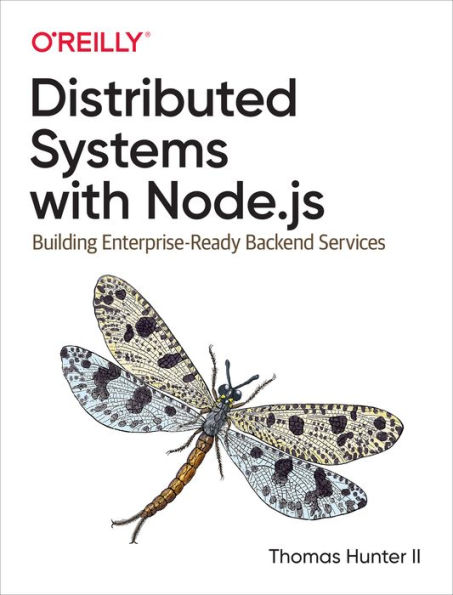Table of Contents
Foreword xi
Preface xiii
1 Why Distributed? 1
The Single-Threaded Nature of JavaScript 1
Quick Node.js Overview 6
The Node.js Event Loop 9
Event Loop Phases 10
Code Example 11
Event Loop Tips 14
Sample Applications 15
Service Relationship 16
Producer Service 17
Consumer Service 18
2 Protocols 21
Request and Response with HTTP 22
HTTP Payloads 23
HTTP Semantics 25
HTTP Compression 26
HTTPS/TLS 29
JSON over HTTP 34
The Dangers of Serializing POJOs 35
API Facade with GraphQL 36
GraphQL Schema 37
Queries and Responses 38
GraphQL Producer 40
GraphQL Consumer 43
RPC with gRPC 45
Protocol Buffers 45
gRPC Producer 48
gRPC Consumer 50
3 Scaling 53
The Cluster Module 53
A Simple Example 54
Request Dispatching 57
Cluster Shortcomings 58
Reverse Proxies with HAProxy 61
Introduction to HAProxy 63
Load Balancing and Health Checks 64
Compression 69
TLS Termination 70
Rate Limiting and Back Pressure 72
SLA and Load Testing 75
Introduction to Autocannon 76
Running a Baseline Load Test 76
Reverse Proxy Concerns 80
Protocol Concerns 84
Coming Up with SLOs 87
4 Observability 91
Environments 92
Logging with ELK 93
Running ELK via Docker 94
Transmitting Logs from Node.js 95
Creating a Kibana Dashboard 98
Running Ad-Hoc Queries 100
Metrics with Graphite, StatsD, and Grafana 102
Running via Docker 103
Transmitting Metrics from Node.js 104
Creating a Grafana Dashboard 106
Node.js Health Indicators 108
Distributed Request Tracing with Zipkin 111
How Does Zipkin Work? 112
Running Zipkin via Docker 115
Transmitting Traces from Node.js 115
Visualizing a Request Tree 118
Visualizing Microservice Dependencies 119
Health Checks 120
Building a Health Check 121
Testing the Health Check 124
Alerting with Cabot 124
Create a Twilio Trial Account 125
Running Cabot via Docker 126
Creating a Health Check 127
5 Containers 131
Introduction to Docker 133
Containerizing a Node.js Service 140
Dependency Stage 141
Release Stage 143
From Image to Container 146
Rebuilding and Versioning an Image 148
Basic Orchestration with Docker Compose 151
Composing Node.js Services 152
Internal Docker Registry 156
Running the Docker Registry 157
Pushing and Pulling to the Registry 158
Running a Docker Registry UI 160
6 Deployments 163
Build Pipeline with Travis CI 165
Creating a Basic Project 165
Configuring Travis CI 167
Testing a Pull Request 168
Automated Testing 170
Unit Tests 172
Integration Tests 174
Code Coverage Enforcement 177
Deploying to Heroku 183
Create a Heroku App 184
Configure Travis CI 185
Deploy Your Application 187
Modules, Packages, and SemVer 190
Node.js Modules 191
SemVer (Semantic Versioning) 193
npm Packages and the npm CLI 197
Internal npm Registry 204
Running Verdaccio 205
Configuring npm to Use Verdaccio 205
Publishing to Verdaccio 205
7 Container Orchestration 209
Introduction to Kubernetes 210
Kubernetes Overview 210
Kubernetes Concepts 211
Starting Kubernetes 214
Getting Started 214
Deploying an Application 219
Kubectl Subcommands 219
Kubectl Configuration Files 222
Service Discovery 226
Modifying Deployments 232
Scaling Application Instances 232
Deploying New Application Versions 233
Rolling Back Application Deployments 235
8 Resilience 239
The Death of a Node.js Process 239
Process Exit 240
Exceptions, Rejections, and Emitted Errors 242
Signals 247
Building Stateless Services 249
Avoiding Memory Leaks 251
Bounded In-Process Caches 252
External Caching with Memcached 256
Introducing Memcached 257
Running Memcached 258
Caching Data with Memcached 259
Data Structure Mutations 260
Database Connection Resilience 262
Running PostgreSQL 262
Automatic Reconnection 263
Connection Pooling 269
Schema Migrations with Knex 272
Configuring Knex 274
Creating a Schema Migration 275
Applying a Migration 276
Rolling Back a Migration 279
Live Migrations 280
Idempotency and Messaging Resilience 284
HTTP Retry Logic 286
Circuit Breaker Pattern 289
Exponential Backoff 289
Resilience Testing 293
Random Crashes 294
Event Loop Pauses 294
Random Failed Async Operations 295
9 Distributed Primitives 297
The ID Generation Problem 298
Introduction to Redis 301
Redis Operations 302
Strings 304
Lists 305
Sets 307
Hash 308
Sorted Sets 310
Generic Commands 311
Other Types 312
Seeking Atomicity 313
Transactions 315
Lua Scripting 317
Writing a Lua Script File 318
Loading the Lua Script 320
Tying It All Together 322
10 Security 325
Wrangling Repositories 326
Recognizing Attack Surface 328
Parameter Checking and Deserialization 328
Malicious npm Packages 331
Application Configuration 332
Environment Variables 333
Configuration Files 334
Secrets Management 337
Upgrading Dependencies 339
Automatic Upgrades with GitHub Dependabot 340
Manual Upgrades with npm CLI 342
Unpatched Vulnerabilities 344
Upgrading Node.js 346
Node.js LTS Schedule 346
Upgrade Approach 347
A Installing HAProxy 349
B Installing Docker 351
C Installing Minikube & Kubectl 353
Index 355



